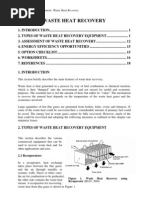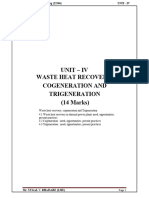Waste Heat
Uploaded by
Hassan MehrizWaste Heat
Uploaded by
Hassan MehrizIntroduction
Waste heat
Waste heat is heat, which is generated in a process by way of fuel combustion or
chemical reaction, and then dumped into
the environment even though it could still
be reused for some useful and economic
purpose.
Large quantity of hot flue gases is
generated from Boilers, Kilns, Ovens and
Furnaces. If some of this waste heat could
be recovered, a considerable amount of
primary fuel could be saved. The energy
lost in waste gases cannot be fully
recovered. However, much of the heat
could be recovered and loss minimized by
adopting certain procedures.
Heat Losses Quality
Depending upon the type of process, waste
heat can be rejected at virtually any temperature from that of chilled cooling water to high
temperature waste gases from an industrial furnace or kiln. Usually higher the temperature,
higher the quality and more cost effective is the heat recovery. In any study of waste heat
recovery, it is absolutely necessary that there should be some use for the recovered heat.
Typical examples of use would be preheating of combustion air, space heating, or pre-heating
boiler feed water or process water. With high temperature heat recovery, a cascade system
of waste heat recovery may be practiced to ensure that the maximum amount of heat is
recovered at the highest potential. An example of this technique of waste heat recovery
would be where the high temperature stage was used for air pre-heating and the low
temperature stage used for process feed water heating or steam raising.
Heat Losses Quantity
In any heat recovery situation it is essential to know the amount of heat recoverable and
also how it can be used. An example of the availability of waste heat is given below:
Heat recovery from heat treatment furnace
In a heat treatment furnace, the exhaust gases are leaving the furnace at
o 3 o
900 C at the rate of 2100 m /hour. The total heat recoverable at 180 C final
exhaust can be calculated as
Q = V x x Cp x T
Q is the heat content in kCal
V is the flowrate of the substance in m3/hr
3
is density of the flue gas in kg/m
Cp is the specific heat of the substance in kCal/kg oC
T is the temperature difference in oC
Cp (Specific heat of flue gas) = 0.24 kCal/kg/ oC
Heat available (Q) = 2100 x 1.19 x 0.24 x (900-180) = 4,31,827 kCal/hr
By installing a recuperator, this heat can be recovered to pre-heat the combustion air.
The fuel savings would be 33% (@ 1% fuel reduction for every 22 oC reduction in
temperature of flue gas.
Low Temperature Heat Recovery
The following Table 8.4 lists some heat sources in the low temperature range. In this
range it is usually not practical to extract work from the source, though steam production
may not be completely excluded if there is a need for low-pressure steam. Low
temperature waste heat may be useful in a supplementary way for preheating purposes.
Waste heat recovery
Waste heat recovery is the collection of heat created as an undesired by-product of the
.operation of a piece of equipment or machinery to fill a desired purpose elsewhere
Waste heat recouping methods range from the simple to the complex. A common simple
example is household water drain heat recovery. In this method, the heat going down a sink
or shower drain is recovered by a copper pipe coiling around the drain pipe. The coil is then
.used to heat water as it passes through pipes on the way to a hot water heater
Benefits of Waste Heat Recovery
:Benefits of waste heat recovery can be broadly classified in two categories
:Direct Benefits
Recovery of waste heat has a direct effect on the efficiency of the process. This is
.reflected by reduction in the utility consumption & costs, and process cost
:Indirect Benefits
a) Reduction in pollution: A number of toxic combustible wastes such as carbon
monoxide gas, sour gas, carbon black off gases, oil sludge, Acrylonitrile and other plastic
chemicals etc, releasing to atmosphere if/when burnt in the incinerators serves dual
purpose i.e. recovers heat and reduces the environmental pollution levels.
b) Reduction in equipment sizes: Waste heat recovery reduces the fuel
consumption, which leads to reduction in the flue gas produced. This results in
reduction in equipment sizes of all flue gas handling equipment such as fans,
.stacks, ducts, burners, etc
c) Reduction in auxiliary energy consumption: Reduction in equipment sizes gives
additional benefits in the form of reduction in auxiliary energy consumption like
..electricity for fans, pumps etc
Commercial Waste Heat Recovery Devices
Recuperators
In a recuperator, heat exchange takes place between the
flue gases and the air through metallic or ceramic walls.
Duct or tubes carry the air for combustion to be pre-
heated, the other side contains the waste heat stream. A
.recuperator for recovering waste heat from flue gases is shown in Figure 8.1
Metallic radiation recuperators
The simplest configuration for a recuperator is the
metallic radiation recuperator, which consists of two
concentric lengths of metal tubing as shown in
Figure 2.
The inner tube carries the hot exhaust gases while
the external annulus carries the combustion air from
the atmosphere to the air inlets of the furnace
burners. The hot gases are cooled by the incoming
combustion air, which now carries additional energy
into the combustion chamber.
This is the energy, which does not have to be
supplied by the fuel; consequently, less fuel is
burned for a given furnace loading.
The saving in fuel also means a decrease in
combustion air and therefore, stack losses are
decreased not only by lowering the stack gas
temperatures but also by discharging smaller
quantities of exhaust gas.
The radiation recuperator gets its name from the fact that a substantial portion of
the heat transfer from the hot gases to the surface of the inner tube takes place by
radiative heat transfer.
As shown in the diagram, the two gas flows are usually parallel, although the
configuration would be simpler and the heat transfer would be more efficient if
the flows were opposed in direction (or counterflow). The reason for the use of
parallel flow is that recuperators frequently serve the additional function of
cooling the duct carrying away the exhaust gases and consequently extending its
service life.
Convective recuperators
Hot gas through parallel small
diameter tubes
Tubes can be baffled to allow gas
to pass over them again
Baffling increases heat exchange
but more expensive exchanger is
needed
A second common configuration
for recuperators is called the tube
type or convective recuperator. As
seen in this figure, the hot gases
are carried through a number of
parallel small diameter tubes,
while the incoming air that is to be
heated enters a shell surrounding
the tubes and passes over the hot
tubes one or more times in a
direction normal to their axes.
Waste heat boiler
Waste heat boilers are ordinarily
water tube boilers in which the hot
exhaust gases from gas turbines,
incinerators, etc pass over a number
of parallel tubes that contain water.
The water is vaporized in the tubes
and collected in a steam drum from
which it is drawn off for use as
heating or processing steam.
This figure illustrates a mud drum
and a steam drum. A mud drum is a
set of tubes over which the hot gases
make a double pass. A steam drum
collects the steam generated above
the water surface. The pressure at
which the steam is generated and the
rate of steam production depends on
the temperature of waste heat. The
pressure of a pure vapor in the
presence of its liquid is a function of
the temperature of the liquid from
which it is evaporated.
Waste heat boilers are built in capacities from 25 m3 almost 30,000 m3 /min. of
exhaust gas.
Plate Heat Exchanger
Parallel plates forming a thin flow pass
Avoids high cost of heat exchange surfaces
Corrugated plates to improve heat transfer
When directions of hot and cold fluids are opposite, the arrangement is counter
current
Heat Pipe
A heat pipe can transfer up
to 100 times more thermal
energy than copper, the
best-known conductor. In
other words, heat pipe is a
thermal energy absorbing
and transferring system that
has no moving parts and
hence require minimum
maintenance.
The heat pipe comprises of
three elements: a sealed
container, a capillary wick
structure and a working
fluid. The capillary wick
structure is integrally
fabricated into the interior
surface of the container
tube and sealed under
vacuum.
Thermal energy applied to
the external surface of the
heat pipe is in equilibrium
with its own vapour as the
container tube is sealed under vacuum. Thermal energy applied to the external
surface of the heat pipe causes the working fluid near the surface to evaporate
instantaneously. The vapour absorbs the latent heat of vaporization and this part
of the heat pipe becomes an evaporator region. The vapour then travels to the
other end the pipe where the thermal energy is removed causing the vapour to
condense into liquid again, thereby giving up the latent heat of the condensation.
This part of the heat pipe works as the condenser region. The condensed liquid
then flows back to the evaporated region.
You might also like
- Simens VDO K16 Pump Reman Line Preliminary Plan v1.0No ratings yetSimens VDO K16 Pump Reman Line Preliminary Plan v1.08 pages
- WEAST HEAT RECOVERY Heating Purpose For Woldia University CaftiriaNo ratings yetWEAST HEAT RECOVERY Heating Purpose For Woldia University Caftiria10 pages
- Syllabus Waste Heat Recovery: Classification, Advantages and Applications, CommerciallyNo ratings yetSyllabus Waste Heat Recovery: Classification, Advantages and Applications, Commercially10 pages
- 4.15.5 Commercial Waste Heat Recovery DevicesNo ratings yet4.15.5 Commercial Waste Heat Recovery Devices13 pages
- Syllabus Waste Heat Recovery: Classification, Advantages and Applications, CommerciallyNo ratings yetSyllabus Waste Heat Recovery: Classification, Advantages and Applications, Commercially9 pages
- Syllabus Waste Heat Recovery: Classification, Advantages and Applications, Commercially100% (2)Syllabus Waste Heat Recovery: Classification, Advantages and Applications, Commercially18 pages
- A Review On Waste Heat Recovery in IndustriesNo ratings yetA Review On Waste Heat Recovery in Industries4 pages
- Waste Heat Recovery From Furnace Flue GasesNo ratings yetWaste Heat Recovery From Furnace Flue Gases3 pages
- Waste Heat Recovery Technologies and Applications: ART-203 Group No:04No ratings yetWaste Heat Recovery Technologies and Applications: ART-203 Group No:0417 pages
- Industrial Waste-Heat Recovery: Benefits and Recent Advancements in Technology and ApplicationsNo ratings yetIndustrial Waste-Heat Recovery: Benefits and Recent Advancements in Technology and Applications13 pages
- Waste Heat Recovery: Training Session On Energy EquipmentNo ratings yetWaste Heat Recovery: Training Session On Energy Equipment32 pages
- Assignment: Cogeneration and Waste Heat Recovery SystemsNo ratings yetAssignment: Cogeneration and Waste Heat Recovery Systems8 pages
- Realization of Exhaust Air Recovery and Waste Heat Recovery Systems For Energy Conservation and Sustainable DevelopmentNo ratings yetRealization of Exhaust Air Recovery and Waste Heat Recovery Systems For Energy Conservation and Sustainable Development5 pages
- A Review of Gas-Gas Heat Recovery SystemsNo ratings yetA Review of Gas-Gas Heat Recovery Systems39 pages
- Waste Heat Recovery and Advanced Burner Technologies Lead To Energy SavingsNo ratings yetWaste Heat Recovery and Advanced Burner Technologies Lead To Energy Savings3 pages
- Industrial Waste Heat Recovery: Alfred PiggottNo ratings yetIndustrial Waste Heat Recovery: Alfred Piggott9 pages
- Encyclopaedia Britannica, 11th Edition, Volume 8, Slice 3 "Destructors" to "Diameter"From EverandEncyclopaedia Britannica, 11th Edition, Volume 8, Slice 3 "Destructors" to "Diameter"No ratings yet
- Thermodynamic analysis of geothermal heat pumps for civil air-conditioningFrom EverandThermodynamic analysis of geothermal heat pumps for civil air-conditioning5/5 (2)
- Design of Mechanical Systems: 5th Term Electromechanical Eng. Program Lecture One Bolted and Riveted Joints Fall 2015No ratings yetDesign of Mechanical Systems: 5th Term Electromechanical Eng. Program Lecture One Bolted and Riveted Joints Fall 201519 pages
- HS 201 Technical Writing: Dr. Alya Badawi Department of Nuclear and Radiation Engineering Alexandria University100% (1)HS 201 Technical Writing: Dr. Alya Badawi Department of Nuclear and Radiation Engineering Alexandria University32 pages
- Pulsation Dampeners For Smooth Flow in Pipes: The K FactorNo ratings yetPulsation Dampeners For Smooth Flow in Pipes: The K Factor3 pages
- Peak Oil Production May Already Be Here (Kerr 2011) Journal of ScienceNo ratings yetPeak Oil Production May Already Be Here (Kerr 2011) Journal of Science2 pages
- Simens VDO K16 Pump Reman Line Preliminary Plan v1.0Simens VDO K16 Pump Reman Line Preliminary Plan v1.0
- WEAST HEAT RECOVERY Heating Purpose For Woldia University CaftiriaWEAST HEAT RECOVERY Heating Purpose For Woldia University Caftiria
- Syllabus Waste Heat Recovery: Classification, Advantages and Applications, CommerciallySyllabus Waste Heat Recovery: Classification, Advantages and Applications, Commercially
- Syllabus Waste Heat Recovery: Classification, Advantages and Applications, CommerciallySyllabus Waste Heat Recovery: Classification, Advantages and Applications, Commercially
- Syllabus Waste Heat Recovery: Classification, Advantages and Applications, CommerciallySyllabus Waste Heat Recovery: Classification, Advantages and Applications, Commercially
- Waste Heat Recovery Technologies and Applications: ART-203 Group No:04Waste Heat Recovery Technologies and Applications: ART-203 Group No:04
- Industrial Waste-Heat Recovery: Benefits and Recent Advancements in Technology and ApplicationsIndustrial Waste-Heat Recovery: Benefits and Recent Advancements in Technology and Applications
- Waste Heat Recovery: Training Session On Energy EquipmentWaste Heat Recovery: Training Session On Energy Equipment
- Assignment: Cogeneration and Waste Heat Recovery SystemsAssignment: Cogeneration and Waste Heat Recovery Systems
- Realization of Exhaust Air Recovery and Waste Heat Recovery Systems For Energy Conservation and Sustainable DevelopmentRealization of Exhaust Air Recovery and Waste Heat Recovery Systems For Energy Conservation and Sustainable Development
- Waste Heat Recovery and Advanced Burner Technologies Lead To Energy SavingsWaste Heat Recovery and Advanced Burner Technologies Lead To Energy Savings
- Encyclopaedia Britannica, 11th Edition, Volume 8, Slice 3 "Destructors" to "Diameter"From EverandEncyclopaedia Britannica, 11th Edition, Volume 8, Slice 3 "Destructors" to "Diameter"
- Thermodynamic analysis of geothermal heat pumps for civil air-conditioningFrom EverandThermodynamic analysis of geothermal heat pumps for civil air-conditioning
- Scientific American Supplement, No. 633, February 18, 1888From EverandScientific American Supplement, No. 633, February 18, 1888
- Design of Mechanical Systems: 5th Term Electromechanical Eng. Program Lecture One Bolted and Riveted Joints Fall 2015Design of Mechanical Systems: 5th Term Electromechanical Eng. Program Lecture One Bolted and Riveted Joints Fall 2015
- HS 201 Technical Writing: Dr. Alya Badawi Department of Nuclear and Radiation Engineering Alexandria UniversityHS 201 Technical Writing: Dr. Alya Badawi Department of Nuclear and Radiation Engineering Alexandria University
- Pulsation Dampeners For Smooth Flow in Pipes: The K FactorPulsation Dampeners For Smooth Flow in Pipes: The K Factor
- Peak Oil Production May Already Be Here (Kerr 2011) Journal of SciencePeak Oil Production May Already Be Here (Kerr 2011) Journal of Science
































































































